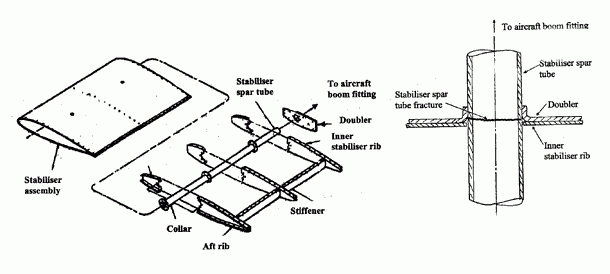FACTUAL INFORMATION
On 15 June 2004, a Hiller Aviation UH-12E helicopter, registered VH-HMT, crashed during an agricultural operation, after the pilot reported a loss of tail rotor authority. The pilot was not injured in the accident. The horizontal stabilizer was found about 150 m from the wreckage site, indicating that it had separated from the helicopter in-flight. The operator reported that damage to the stabiliser and the tail rotor blades was consistent with the separated stabiliser coming into contact with the tail rotor blades, as it was still connected to the helicopter by the taillight wiring. The operator reported that an engineering examination found no evidence of tail rotor system failure.
The horizontal stabiliser spar tube failed in the area where the tube passes through a collar in the doubler attached to the inner stabiliser rib (refer to figure 1).
Figure 1: Horizontal stabiliser and detail of the spar tube and doubler.
Helicopter
The helicopter was manufactured in 1978 and had accumulated 6,903.50 hours time in service at the time of the accident. In September 2002, at 6,386.25 hours in service, it sustained major damage following a sudden main rotor stoppage. The helicopter was rebuilt and had since accumulated approximately 517.20 hours in service. It was maintained in accordance with the maintenance requirements applicable at the time and had a valid Maintenance Release. It had flown approximately 31 hours since the last periodic inspection, a 100 hourly inspection completed in May 2004.
Horizontal stabiliser
The operator advised the Australian Transport Safety Bureau (ATSB) that the horizontal stabiliser is not a serial numbered item and its time in service since new was not known. The stabiliser was fitted to the helicopter when it was acquired from its previous owner. During the helicopter rebuild in September 2002, the stabiliser was inspected in accordance with the 100 hourly component inspection guide and the Hiller UH-12E maintenance manual, before being re-installed. The component inspection guide required the stabiliser tube to be inspected for corrosion and security and the maintenance manual detailed the spar tube inspection requirements and wear limits. No anomalies with the horizontal stabiliser were reported at that time.
Spar tube failure
The failed horizontal stabiliser was forwarded to the ATSB for detailed examination. That examination revealed that the stabiliser spar tube fractured as a result of fatigue cracking. The crack initiation occurred at a number of locations where the tubing had been reduced in wall thickness by wear. It was apparent that the wear of the tubing was associated with small scale repeated movement between the stabiliser tube and the doubler attached to the stabiliser's inner rib. There was no evidence of any pre-existing defect present.
A search of the ATSB, United States National Transportation Safety Board and Federal Aviation Administration databases found no reported events involving an in-flight separation of the horizontal stabiliser on similar helicopter types.



